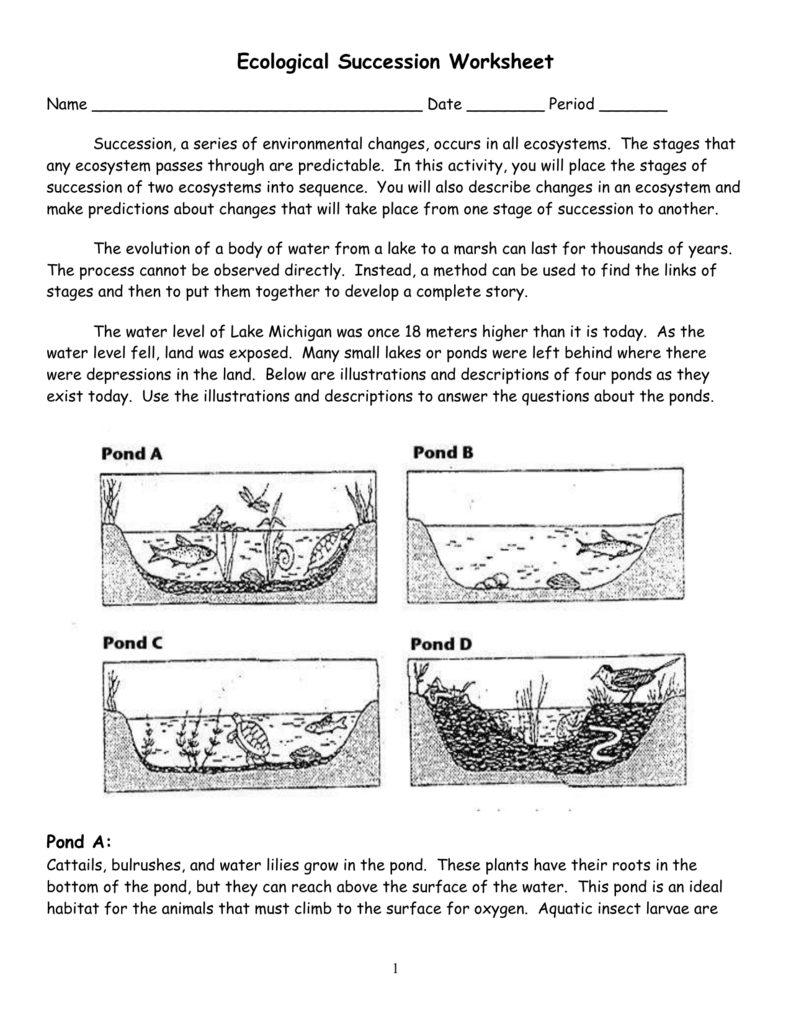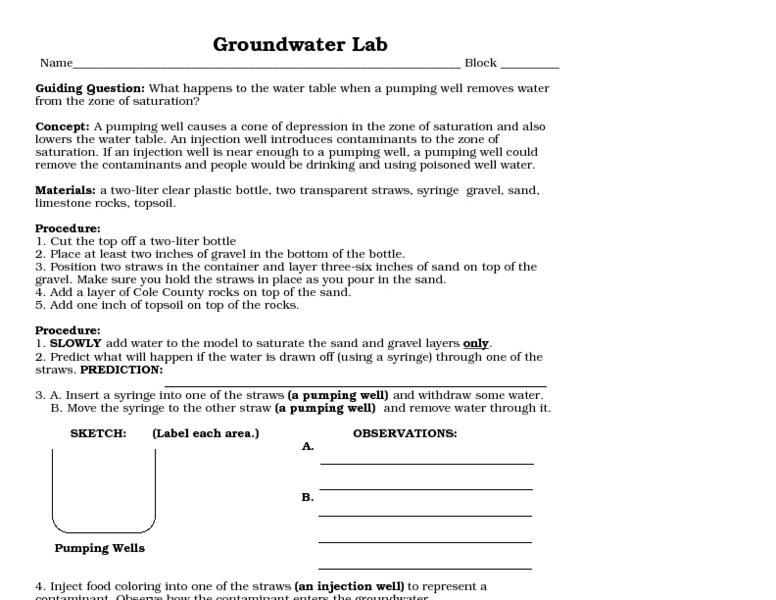42 pond water lab worksheet
PDF Pond Water Webs Answer Sheet - Crystal Clear Education Pond Water Webs:Worksheet Answers 1. Producers =phytoplankton, seaweed 2. Carnivore =fish, gull, lobster, prawn, crab, whelk Omnivore =mussels Herbivore = zooplankton, limpets 3. (a)We would expect the limpet population to decrease since the organisms that eat mussels would have to eat more limpets. PDF Lesson Plan: Yucky Water! A Water Quality Lab Investigation • Water samples (tap, stream, and polluted, see Teacher Notes at end of lesson). Time Needed: • Assign pre-lab homework 2 days before lab • 15 minutes to review pre-lab homework and to introduce activity day before lab • 60-minute class period for lab activity • 15 minutes for post-activity class discussion the day after lab
pond water microscope lab - Teachers Pay Teachers Miss Middle School Teacher. 36. $1.00. PDF. Pond Water Microscope Activity/Lab by Miss Middle School Teacher This lab activity is a great way to explore microscopic organisms living in local ponds, streams, and lakes. I use this during my life sciences/cells unit with middle schoolers. After discussing protists and fungi, we predict what ...
Pond water lab worksheet
PDF pond water lab - Weebly 1)Carefully observe the pond water sample in the collection jar. Look for movement and any green organisms. Organisms that are green contain the pigment chlorophyll and are probably algae. 2)Following the teachers directions, use the pipette to collect water from the sample jar and make a slide. Observe your slide under low power. Lab Worksheets - General Biology BSC 2005 lab#1 potato onion v2 lab#2 sci method and pond water v4 lab#2 Sci Method and Pond water v4 lab#3 Cells Osmosis Diffusion v2 lab4-nutrition-detecting-biological-molecules-v3 lab5-mitosis-meiosis-cell-cycle-cancer lab6-mendelian-genetics-count-corn-more-meiosis-mitosis lab7-dna-fingerprinting lab8-genetics-practice-questions lab8-microevolution-and-population-genetics Pond Water lab, Results Page - Course Hero Procedure At first the author got the pond water at Randal Park on October 19, 2014. It was a sunny day. The conditions around the pond were that it was muddy around the water. Also there were duck and goose feces. There were also leaves around the water. For the most part it was pretty clean around the pond.
Pond water lab worksheet. Pond Water Under the Microscope Pond Water Preparation 1. Gently stir the jar containing the water sample in order to ensure uniform distribution of organisms in the water. 2. Using a dropper, place two or three drops of pond water at the center of a clean, sterile microscopic slide. 3. PDF Pond Water Pond Water Web WebWeb ---- Lesson Plan Lesson Plan Lesson Plan Pond Water Pond Water Web WebWeb ---- Lesson Plan Lesson Plan Lesson Plan Purpose : As a result of this lesson, students will become familiar with common organisms found in a pond ... Pond Water Webs ANSWER KEY Student Worksheet Use the food web to complete #1-3. 1. Which organisms are the producers? PDF LAB Pond Water Organisms - Denton ISD 7thLAB Pond Water Organisms Draw any organism that you saw that is not in the above table. Analysis and Conclusions 1. How many different microorganisms did you discover? 2. Which kind of microorganism had the highest population?(refer to your drawings) ___________ 3. What do you think microorganisms eat? 4. PDF Teacher Notes - The Science Spot Provide copies of the lab worksheet to allow students to document their observations. ... found in the pond water samples to determine which organisms were most abundant. Use the data to create graphs or charts to compare the population of several of the species. 5. If you have access to a computer microscope or camera, allow time for students ...
Pond Water Lab Flashcards | Quizlet Pond Water Lab STUDY Flashcards Learn Write Spell Test PLAY Match Gravity Created by leventhalkyle Terms in this set (30) Ecology Study of ecosystems Ecosystem Habitat where organisms live Decomposers Bacteria and Fungi Cause decaying Producers Organisms that get energy from photosynthesis Consumers Organisms that eat other organisms for energy Pea Soup Ponds: Algae Investigation & Analysis for Water Quality - Activity Label the jars with masking tape or wax pencils. Include the group number or name, student's name, and amount of fertilizer added. Have the students add fertilizer first, and then fill with aged tap water to within a centimeter of the top. Add one eyedropper full of live algae to each sample jar. Leave jars uncovered. Pond Water Lab Teaching Resources | Teachers Pay Teachers It includes a guided lab sheet and a pond water critter guide for them to identify the organisms they see in the pond water. In this lab they are able to look at pond water in the microscope and use the guide to figure out what they see in the pond water. They are able to identify unicellular and multicellular organisms. DOC Title: Pond Water Lab - Institute for Emerging Issues 1. Collect a few drops of water from the bottom of your water sample using an eye dropper. 2. Place a drop on the center of the microscope slide. 3. Cover the slide with a cover slip by lowering the cover slip at an angle over the water drop in a manner that spreads out the water drop, but does not trap air bubbles. 4.
DOC Author: Gail Powell - Kenan Fellows Program Sample Lab Report. Microbe Worksheet. Activity: 1. The teacher initiates a student discussion to see what students expect to find in our drops of pond water. Link the discussion to the concept of food chains and ecosystems. Ask questions about things that might get into a pond from human activity. Pond Water – A Closer Look Lab Procedure. 1. Put a very small drop of pond water on a slide. ... Work through the lab procedure ... A simple guide to small and microscopic pond life.3 pages Pond Water Lab | Teaching Resources Students investigate pond water organisms under the microscope and answer follow-up questions. International; Resources; ... Pond Water Lab. Subject: Biology. Age range: 11-14. Resource type: Worksheet/Activity (no rating) 0 reviews. hstewart05. 4.4375 15 reviews. Last updated. 19 August 2015. Share this. Share through email; Share through twitter; PDF Pond Life: Macro & Microscopic Views Teacher Guide - Fisher Sci Then switch to a compound microscope and prepare a wet mount slide of the pond water. Begin by examining the water under 100X and gradually increase the magnifying power up to 400X. Answer questions 3 and 4 below. Initial Examination Use the stereo microscope to view your water samples under low power (10X- 40X), and answer the questions below. 1.
Examine an Ecosystem - The Biology Corner Your task is to collect data on both pond samples using the equipment provided and record data. 1. Initial Observations From the outside of the jar, describe the condition of the water, and any organisms you can see. Check to see if the water has an odor. Record this initial qualitative data on your pond samples. 2. Testing the Waters
A virtual pond dip - Microscopy-UK Return to jar of pond water. References (The following were used, but any errors are the current author's!). 1) 'Five Kingdoms: An illustrated guide to the phyla of life on earth'.By L Margulis and K V Schwartz, 3rd edition, W H Freeman, New York, 1998. Classification of some freshwater micro-organisms always seem to be in a state of flux!
Lab 1: The Laboratory Microscope - Mountain Empire Community College Lab 1: The Laboratory Microscope ... Instead, fill the jar partway with pond water and then squeeze water into the container from water plants or pond scum. 2. Prepare a specimen of pond water. a. Using the dropper, place a few drops of pond water onto the center of a clean, dry slide. b. Hold the side edges of the coverslip and place the ...
S-6-3-2_Virtual_Pond_Water_Lab_Activity_and_KEY.docx Answer KEY Virtual Pond Water Lab Activity Directions: 1. Before they begin, direct students to read through the lab worksheet. Answer any questions students may have. 2. Assist students by answering questions as they conduct the virtual activity. Answers will vary, depending on which organisms that students select from the jar.
PDF Pond Water Lab: Biodiversity of Ponds - Mr. Rott's Science Room Data: Pond Water Observations Algae Observation: 1. With forceps, transfer a few strands of algae from your sample of pond water to a slide 2. Add 2 drops of pond water 3. Observe under low power 4. Move slide to bring all areas into view 5. Sketch a small section of each kind of algae you see 6. Label the algae you can identify
PDF Laboratory #7: Preparing a Wet Mount Background Information: Why would ... Lab Procedure: Now using the skill of constructing a wet mount, follow the steps above to help you. 1.) Set up your microscope at your workstation. 2.) Prepare your first wet mount. When it is complete, look at it under the microscope. Draw what you see. 3.) Now, prepare a wet mount with too much water. Draw what you see and make
PDF Pond Water Observation Lab - bu.edu Materials and Methods: Slide Coverslip Glycerin Microscope Water sample Get a drop of glycerin on your slide. Ask a teacher for a pond water sample. CAREFULLY lower the coverslip onto the slide—you don't want to crush any of the organisms!! The glycerin should slow them down enough for you to draw them.
Vritual Pond Dip - The Biology Corner -Find the answers to each of the questions by exploring the jar and clicking on each organism. 1. What is the largest organism in the jar? How does this animal capture food? 2. What organism is pictured? Why are these organisms easy to spot in the water? 3. What organism is long and stringy and found at the top of the jar? 4.
Activity: Determining Water Quality | Teaching Great Lakes Science Jar 1 - Add enough coffee grounds and cocoa powder until the water has a good "dirty" look. Label it jar 1. Jar 2 - Add food coloring so that the water appears clear purple. Label it jar 2. Jar 3 - Add a trace of hydrochloric acid. The HCl solution should be clear and colorless. Label it jar 3. Jar 4 - Add a few tablespoons of kosher table salt.
Pond Dip - Bring an Ecosystem into the Classroom Pond Dip - Bring an Ecosystem into the Classroom. Studying aquatic microorganisms is engaging and very educational. Here I share how I teach a 7th grade lab on finding protists and microscopic animals in pond water. This may seem daunting if you are not familiar with the organisms or haven't had the time to organize the activity.
Ward's® Investigating Pond Life Lab Activity - VWR Ward's® Investigating Pond Life Lab Activity. Educational Classroom Kits and Activities. ... snails, Hydra, Planaria, and a host of freshwater protists in a 32 oz. water sample. Set comes with materials for 30 students, and a teacher's manual with background information and full-color dichotomous key. ...
Pond Water lab, Results Page - Course Hero Procedure At first the author got the pond water at Randal Park on October 19, 2014. It was a sunny day. The conditions around the pond were that it was muddy around the water. Also there were duck and goose feces. There were also leaves around the water. For the most part it was pretty clean around the pond.
Lab Worksheets - General Biology BSC 2005 lab#1 potato onion v2 lab#2 sci method and pond water v4 lab#2 Sci Method and Pond water v4 lab#3 Cells Osmosis Diffusion v2 lab4-nutrition-detecting-biological-molecules-v3 lab5-mitosis-meiosis-cell-cycle-cancer lab6-mendelian-genetics-count-corn-more-meiosis-mitosis lab7-dna-fingerprinting lab8-genetics-practice-questions lab8-microevolution-and-population-genetics
PDF pond water lab - Weebly 1)Carefully observe the pond water sample in the collection jar. Look for movement and any green organisms. Organisms that are green contain the pigment chlorophyll and are probably algae. 2)Following the teachers directions, use the pipette to collect water from the sample jar and make a slide. Observe your slide under low power.











0 Response to "42 pond water lab worksheet"
Post a Comment